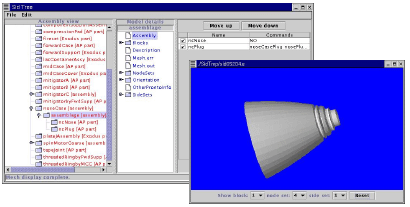



| Projects || Research and Development || Distributed Information Systems Laboratory (DISL) || About Us || Working With Us |
High Performance Scaleable Software
|
|||||||||||||||||||||||||||||||||||||||||||||||||||||||||||||||||||||||||||||||||||||||||||||||||||||||||||||||||||||||||||||||||||||||||||||||||||||||||||||||||||||||||||||||||
|
SIMBA is a software tool to help analysts construct complex hierarchical models for FEA (Finite Element Analysis) simulations.
Associated with each of these parts are numbering and naming schemes for finite element entities such as nodes, elements, surfaces, boundary sets, and material regions. To properly aggregate these parts into a coherent model, numbering and naming conventions must be mutually agreed on and rigidly followed. Currently, these conventions and schemes are maintained ad hoc in notebooks, spreadsheets, and people's heads. The SIMBA workspace allows simulation models to be easily constructed and managed. One goal (popular with the analysts) is the automation of many necessary but tedious bookkeeping tasks, leaving the analyst free to concentrate on the engineering features of the model. SIMBA provides symbolic names for underlying numeric identifiers, a convenient drag & drop interface for model assembly, and visualization tools for checking proper assembly, greatly lowering the barrier for simulation model construction. In its workspace, SIMBA retains the provenance of the originally
imported part models, various modeling alternatives considered,
and descriptive comments provided by the analyst during construction.
The total "model in context" is persisted as a collection
of XML documents, and is appropriate for archival, reuse, or sharing.
|
||||||||||||||||||||||||||||||||||||||||||||||||||||||||||||||||||||||||||||||||||||||||||||||||||||||||||||||||||||||||||||||||||||||||||||||||||||||||||||||||||||||||||||||||
High Performance Scalable Software || Information Security || Cluster Computing & Visualization || Information Systems & Solution
Distributed Information Systems - Home Page
Projects || Research and Development || Distributed Information Systems Laboratory (DISL) || About Us || Working With Us
SNL/CA Homepage
|| Who We Are
|| Our Work
|| Working with Us
SNL Corporate Home
|| Employment
|| Internships
|| Search
|| Index
|| Employee
Locator
Privacy
& Security
| Last Modified: February 3, 2002 Comments to Ken Washington |
Site
Designed by CA Webworks |
| Pages Maintained by : Linda Armijo |
 A
weapon model of a system like the B83 is typically built in a hierarchical
fashion with contributions from multiple analysts. For example
at the top level a weapon model may consist of a nose, a mid-case,
and a tail. The tail, in turn, might consist of a case and
four fins. And so on. A high-fidelity weapon model might
have a hundred or more such parts.
A
weapon model of a system like the B83 is typically built in a hierarchical
fashion with contributions from multiple analysts. For example
at the top level a weapon model may consist of a nose, a mid-case,
and a tail. The tail, in turn, might consist of a case and
four fins. And so on. A high-fidelity weapon model might
have a hundred or more such parts.